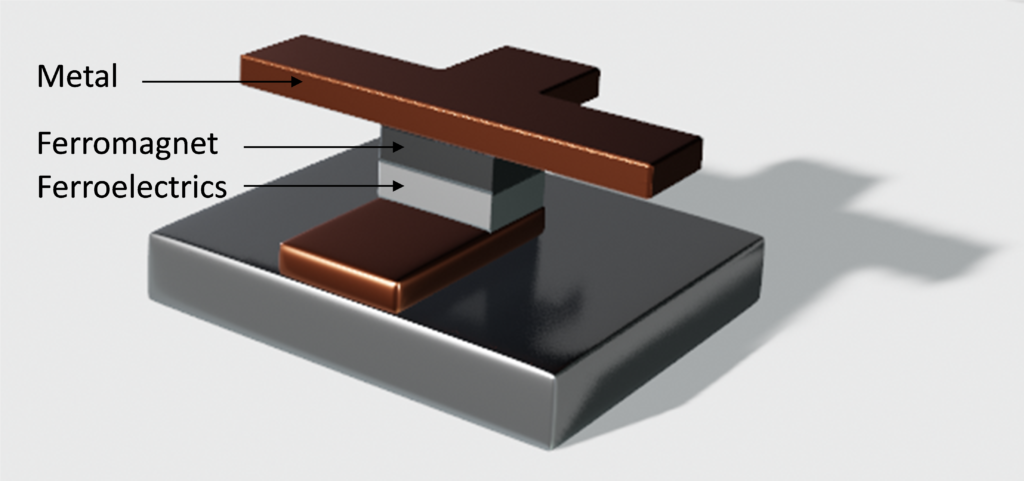Keywords: Microelectronics, spintronics, ferroelectrics, Fe-RAM, Fe-FET, Design, post-CMOS electronics
Summary: Spintronics devices involve ferromagnetic elements with high switching energies. Contrastingly, the polarization of ferroelectrics can be easily switched by an electric field, at energies typically 1000 times lower. This makes ferroelectrics good candidates for ultralow-power neuromorphic AI architectures.
We recently demonstrated in a Nature article that combined with high spin-orbit coupling elements, ferroelectrics have also a natural potential to generate an electrically-switchable, highly efficient spin-charge interconversion that can be used to develop new ferroelectric devices (cf. fig. 1). These patented devices are based on a quantum phenomenon called the Rashba effect, which we have shown to provide a great spin-charge conversion efficiency . At the cross-road between spintronics, ferroelectricity and quantum materials physics, these devices generate, manipulate and convert spin currents using electric fields, in a non-volatile way, thus without resorting to the energy-costly magnetization switching.
The aim of this Post-Doc is to participate to a valorization effort by developing and testing hybrid ferroelectric-spintronics memories and post-CMOS devices.
Description: To contain the ever-increasing power consumption of information and communication systems, resorting to ferroic systems with collective switching behaviour and non-volatility appears essential, in order to bring memory into logic and to alleviate energy-costly on-chip data transfer. Here, the possibility to use the Hall geometry and partial polarization states are fundamental assets to develop ultralow power solutions.
We are looking for a candidate with a profile oriented towards spintronics or ferroelectrics, with an experimental, theoretical or design profile. The Post-Doc will work in collaboration with the team of M. Bibes at Unité Mixte de Physique CNRS/Thales. She/He will also participate to the supervision of PhDs and internships, in collaboration with the Design team of the Spintec Laboratory. She/He will benefit from the existence of a large collective momentum in our teams towards the development and integration of these devices, with ongoing ANR and EU projects, and more importantly with a valorization project aiming at creating a start-up based on this technology.
References: Noël, Attané, Vila et al., Nature 580.7804 (2020): 483 ; Nature Reviews Materials, 7(4), (2022), 258.
Nature communications 4 (2013): 2944. ; Nature materials 15.12 (2016): 1261.; Nature materials, 18(11), (2018) 1187-1193. ; Nature Electronics, 4(10), (2020) 740.
Requested skills: Imagination, inventiveness, interest towards innovative microelectronics applications, and towards intellectual property creation. Experimental, theoretical or design profiles are welcome. Possible will to pursue a career in a start-up environment.
Contacts: Jean-Philippe Attané and Laurent Vila

Fig. 1 : Scheme of our new ferroelectric spintronics device. The dimensions are nanometric.




